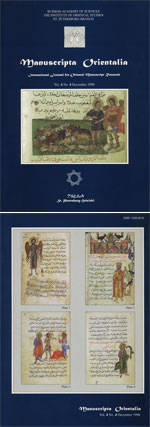|
|
| |

|

|
Vorobyova-Desyatovskaya M., Tyomkin E. Fragments of Sanskrit Manuscripts on Birch-Bark from Kucha // Manuscripta Orientalia. Vol. 4, No 4, December 1998. P. 21-26.
Among the Central Asian materials in the collection of the St. Petersburg Branch of the Institute of Oriental Studies, which were discovered and acquired in East Turkestan in the late nineteenth and early twentieth century, the Sanskrit manuscript fragments on birch-bark are of special interest. In all likelihood, they were copied in India in the first centuries A.D. and found their way to East Turkestan during the first stage of Buddhism’s expansion in the region. A comparison of these fragments with the fragments on birch-bark and palm leaf from the Turfan collection in Germany shows that they are similar both in palaeography and content. Palaeography data allow us to date the fragments of both collections to the Kushan and post-Kushan period. On the basis of contents, the fragments could be divided into several groups, among which the most frequently encountered are excerpts from the Buddhist philosophical canon — the Abhidharma-pitaka, medical texts, sūtras from the Sūtra-pitaka, jātakas and avadānas — extracts from the Sūtra-pitaka and Vinaya-pitaka.
In sum, the St. Petersburg collection contains around 100 fragments of manuscripts on birch-bark which seem to belong to no more than 10—12 manuscripts. The majority of the fragments were acquired by N. F. Petrovsky, the Russian consul in Kashghar. Several fragments from Kucha were brought by M. M. Berezovsky. We know that N. F. Petrovsky usually bought manuscripts from the local population, and the original place of their discovery remain obscure. His shipments frequently consisted of small fragments of birch-bark intermingled with fragments of palm leaf; the first inventory of the collection marked them as manuscripts on palm leaf. For example, call number SI P/43 is common to 10 fragments of various manuscripts of which three are copied on birch-bark and the remainder on palm leaf. Of these three fragments, one, with text on both sides, belongs to a manuscript of medical content; the two others, insignificant in size and with text only on one side, remain unidentified. The five fragments under call number SI P/31 were published by S. F. Oldenburg. They are copied on a thick bast layer of birch-bark. A part of scroll SI P/32a — from the same layer of birch-bark, dimensions 7.3 X 57.0 cm — was also published by Oldenburg. This manuscript contains the Mahāsahasrapramardinī, which constitutes one of the texts of the Pancarakşā.
The current publication includes four fragments held under call number SI P/16. In contrast to his usual practice, in this particular case N. F. Petrovsky indicated that these fragments originated from Kucha. In all, 32 fragments are held under this call number. It appears that they belong to three separate manuscripts. The folios of these manuscripts were originally pasted together from two or three thin layers of birch-bark. At present, the bulk of these fragments have come apart. Fortunately, we have succeeded in putting together four larger fragments from the smaller pieces.
Fragment No. 1 was originally two-layered; we were able to unite six separate pieces and to restore fully one layer. The second layer, the reverse side of the folio, contains a number of crumbled places and lacunae. The extant layers were so brittle and fragile that it was only with great difficulty that we managed to join them. Then the fragment was preserved between two plates of glass. Fragment No. 2 consists of two parts and only one layer of birch-bark. It seems that the third fragment belonged originally to a three-layered folio: two layers have survived, but there is no text on the reverse side. The fragment is put together from two pieces with a minor lacuna between them. A small scrap from this fragment has also survived. Finally, the fourth fragment consists of a single layer of birch-bark put together from two pieces. As a result, we were able to join ten of the largest fragments. The remaining 22 tiny fragments apparently belong to three manuscripts — two are two-layered and one is three-layered. Unfortunately, we have not succeeded in putting them together…
 PDF-files PDF-files
The entire paper
Keywords
Kucha
Manuscripta Orientalia, selected papers
Sanskrit manuscripts
|
|
|
|
Random news: Announcements |
|
A.V. Mesheznikov has submitted his dissertation for the degree of Candidate of Sciences in History titled “Sanskrit manuscripts as sources on the history of Buddhism in Khotan in I–IX centuries” to the Department of Manuscripts and Documents. |
|
Read more...
|
|
|
|
|

